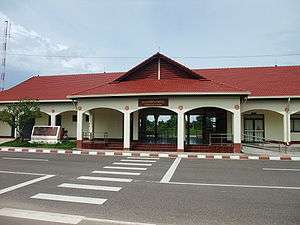Thanaleng station
Thanaleng station, also known as Dongphosy station (Ban Dong Phosy in Lao), is a railway station in Dongphosy village, Hadxayfong District, Vientiane Prefecture, Laos. It is 20 km (12 mi) east of the Lao capital city of Vientiane and 4 km (2.5 mi) north of the Lao-Thai border on the Mekong River. The station opened on 5 March 2009, becoming part of the first international railway link serving Laos.[1] Originally intended for use as a passenger station, Lao officials have stated their intention to convert it to a rail freight terminal to provide a low-cost alternative to road freight, the main mode of transport for goods entering Thailand.[2] The station provides a connection between Vientiane and the capital cities of three other ASEAN nations: Thailand, Malaysia, and Singapore, and several major Southeast Asian ports.[1][3][4]
Thanaleng railway station | |||||||||||
|---|---|---|---|---|---|---|---|---|---|---|---|
 Thanaleng Station | |||||||||||
| Location | Dongphosy village, Hadxayfong District, Vientiane Prefecture, Laos | ||||||||||
| Owned by | State Railway of Thailand | ||||||||||
| Line(s) | Northeastern Line | ||||||||||
| Platforms | C | ||||||||||
| History | |||||||||||
| Opened | 5 March 2009 | ||||||||||
| Traffic | |||||||||||
| 2,500 - 3,000 daily | |||||||||||
| Services | |||||||||||
| |||||||||||
History
On 20 March 2004, an agreement between the Thai and Lao governments was signed to extend the State Railway of Thailand's Northeastern Line from Nong Khai to Thanaleng, a town on the Lao side of the Mekong. The Thai government agreed to finance the line through a combination of grants and loans.[5] The estimated cost of the Nong Khai–Thanaleng line was US$6.2 million, of which 70% was financed by Thai loans.[4] Construction formally began on 19 January 2007,[6] and test trains began running on 4 July 2008.[5] Formal inauguration occurred on 5 March 2009.[7][8] Thanaleng Station is the only station of the Bangkok–Thanaleng rail route on the Lao side of the border.
Proposed extension
On 22 February 2006, after the conclusion of a trilateral agreement between Thailand, Laos, and France, the French Development Agency announced that it had approved funding for a second phase of the Thanaleng railway—an extension to Vientiane. The cost of this second phase was estimated at US$13.2 million, including the cost of feasibility studies, infrastructure, and equipment.[9] A US$50 million loan was also reportedly received from the Thai government for the extension.[3] Construction was originally slated to begin in December 2010, and Lao railway officials had confirmed as late as September 2010 that plans would go ahead. The extension, which would have taken an estimated three years to complete, would have stretched 9 km (5.6 mi) from Thanaleng to a new main station in Khamsavat village in Vientiane's Xaysetha District, 4 km (2.5 mi) away from That Luang Temple.[3]
In November 2010, however, Lao and Thai officials confirmed that their joint extension project had been scrapped in favor of a new line supported by the governments of Thailand and China, which would pass through Laos. The project, which would link Nong Khai with the Chinese city of Kunming, would involve the construction of a new bridge across the Mekong, closer to Vientiane. After reviewing the project, Lao officials decided that Thanaleng station would be converted into a terminal for freight trains crossing over the Thai–Lao Friendship Bridge; freight could then be transported from Bangkok into Laos at a lower cost than would be possible with road transport.[2] The Laotian section will be opened in 2021.
Facilities

Thanaleng station is in a somewhat isolated area southeast of Vientiane, in Dongphosy village. Travellers arriving at the station must arrange their own travel onward into Vientiane, or use tuk-tuks or buses that may be stationed there to await travellers.[1] A transfer counter now operates at the station, where passengers requiring transfer into Vientiane pay a flat rate for transportation into the city, by tuk-tuk or minivan.[10]
Lao tourist visas are available on arrival at Thanaleng. Entry and exit fees are collected at the station upon embarking or disembarking.[10]
As of September 2010, an estimated 2,500 to 3,000 passengers were using the Nong Khai–Thanaleng train daily. Trains consist of two coaches, each carrying up to 80 passengers.[3] Tickets onward to Bangkok may be purchased at the station; passengers travelling through must alight the train at Nong Khai to pass through Thai customs and immigration.[10]
Train services
- Local No. 913/914 Nong Khai- Thanaleng- Nong Khai
- Local No. 917/918 Nong Khai- Thanaleng- Nong Khai
Notes and references
- References
- Andrew Spooner (2009-02-27). "First train to Laos". The Guardian. Retrieved 2011-03-13.
- Rapeepat Mantanarat (2010-11-09). "Laos rethinks rail project". TTR Weekly. Archived from the original on 2013-02-05. Retrieved 2011-03-13.
- Rapeepat Mantanarat (2010-09-03). "Vientiane rail track on the way". TTR Weekly. Archived from the original on 2013-12-25. Retrieved 2011-03-13.
- United Nations Economic and Social Commission for Asia and the Pacific (2009). Review of Developments in Transport in Asia and the Pacific 2007: Data and Trends (2 ed.). United Nations Publications. p. 134. ISBN 92-1-120534-4.
- "Testing takes train into Laos". Railway Gazette International. 2008-07-07.
- "Laos link launched". Railway Gazette International. 2007-03-01.
- Naowarat Suksamran (2009-05-03). "Thai-Lao train service launched". Bangkok Post.
- "Thai-Laos Rail Link, Thailand". Railway Technology. Retrieved 2011-03-13.
- Saeung, Sopaporn (23 February 2006). "France okays Thai–Laos railway link" Archived 2012-10-08 at the Wayback Machine, The Nation.
- Overland travel to Laos. Seat61.com. 2011-03-06.
External links
| Wikimedia Commons has media related to Thanaleng Railway Station. |
- Thai-Laos Rail Link, Thailand. Railway-technology.com.
- Video